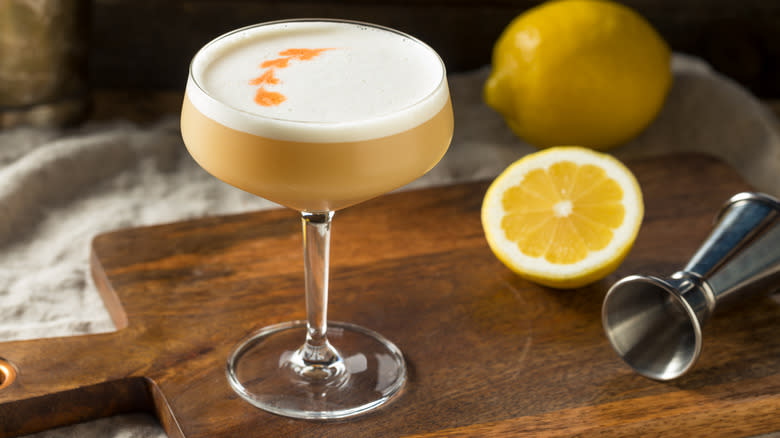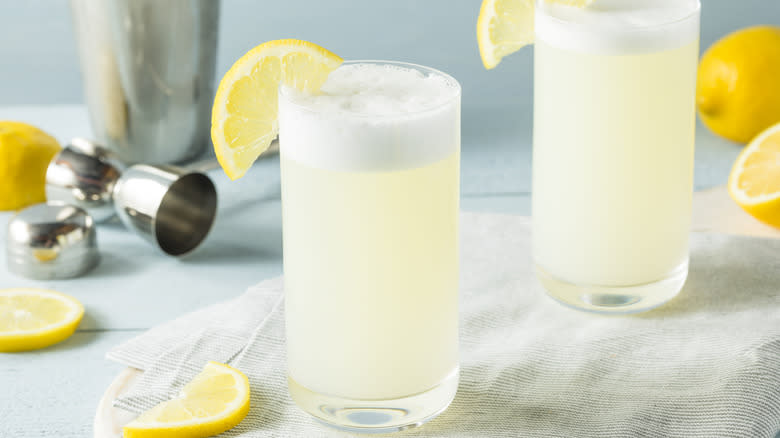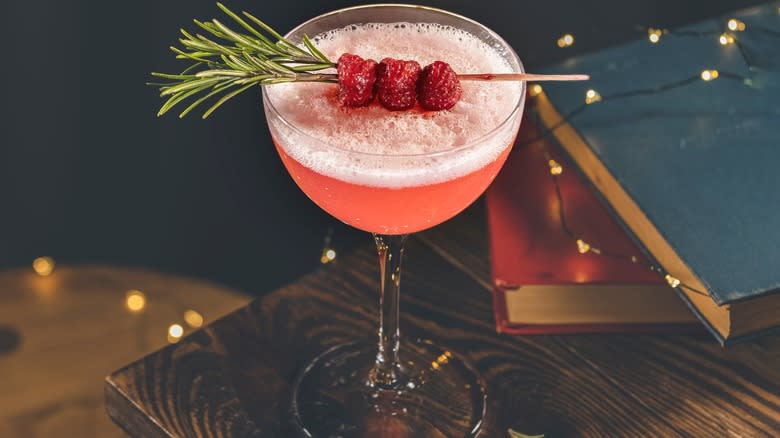How To Get The Perfect Egg Foam For A Classic Frothy Cocktail

The ideal egg white cocktail has a smooth, velvety layer of foam on the top, providing an amazing frothy texture to every sip. To achieve this, bartenders say that the secret is the dry shake technique, or shaking up your drink without ice to form most of the foam. Speaking to Liquor.com, Yann Bouvignies, the head bartender at Scarfes Bar in London, says dry shaking "... allows you to maximize the effect of emulsification by unraveling the [egg] proteins so they can trap the maximum amount of air in your drink." Shaking egg whites is similar to what happens when you whisk them for the meringue topping on a lemon pie: The proteins unravel and form around pockets of air and water, which creates a silky-smooth foam.
The ice is excluded from a dry shake because egg whites emulsify properly at warmer temperatures, so a cold "wet" shake (meaning a shake with ice) alone won't give you velvety-smooth foam. That's not to say that the wet shake isn't needed; it's just a separate step that usually comes after an initial dry shake.
You'll want to get the proper shaking process down, because cocktails that call for the step rely it on it for the right taste, texture, and appearance. Egg foam doesn't necessarily change the flavor of your cocktail, but in addition to adding a creamy texture, it can lessen some of the sourness or bitterness of your drink. It can also make your drink look very visually appealing.
Read more: The Ultimate Vodka Brands, Ranked
Dry Shake Versus Reverse Dry Shake

There are two options for dry and wet shaking your egg-based cocktail: You can vigorously dry shake all of your cocktail components for up to 30 seconds, then add ice for the wet shake to finish. Or, you can do a reverse dry shake, which involves wet shaking first, then straining the drink to remove the ice and finishing with a dry shake. The order in which you do the two shaking steps is up to personal preference, though some bartenders claim that reverse dry shaking yields more foam.
If shaking for so long is causing your arm to cramp, or if you're making multiple egg white cocktails, you can always try using a blender or milk frother to create your egg foam. But to truly impress your friends, try your hand at using a classic cocktail shaker. Always use a firm grip when dry shaking to prevent making a big mess, as unchilled drinks have a higher chance of leaking from the shaker. According to Yann Bouvignies, "Your cocktail shaker might try to push itself apart because warm drinks don't seal the shaker tightly like cold ones do." Hence, it's possible that reverse dry shaking would create a tighter seal, since the shaker will still be somewhat cold from the ice. No matter what type of cocktail you're shaking, try to shake it over your shoulder to avoid soaking your friends, in case the shaker does come apart.
Two Classic Egg-Based Cocktails To Try

Bartenders have been creating foamy egg drinks (such as flips, eggnog, sours, and fizzes) for centuries. One of the most popular egg-white-based cocktails, the pisco sour, consists of pisco (a grape-distilled spirit), lime juice, egg whites, and bitters. This sweet-and sour-drink with a foamy topping has debatable origins. It traces back to the mid-19th to early 20th centuries, with Peruvians and Chileans both laying claim to its inception.
The Clover Club is another classic egg white cocktail with a complex history. Made with gin, raspberry syrup, lemon juice, and egg whites, this drink was beloved during the late 1800s to early 1900s by a group of wealthy businessmen also called the Clover Club. However, by the 1930s, the pink drink was seen as too feminine to be taken seriously by powerful gentlemen, and Esquire magazine even called it one of the worst drinks of the decade.
However, this foamy cocktail might just be making a comeback. Mixologist Julie Reiner has been doing her part in breaking barriers and bringing back the pink drink as co-owner of the world-renowned, award-winning Brooklyn cocktail bar Clover Club. The name now has a triple meaning as a vintage gentlemen's society, a tasty egg white drink, and a modern New York bar.
Read the original article on Daily Meal.

 Yahoo Movies
Yahoo Movies 
